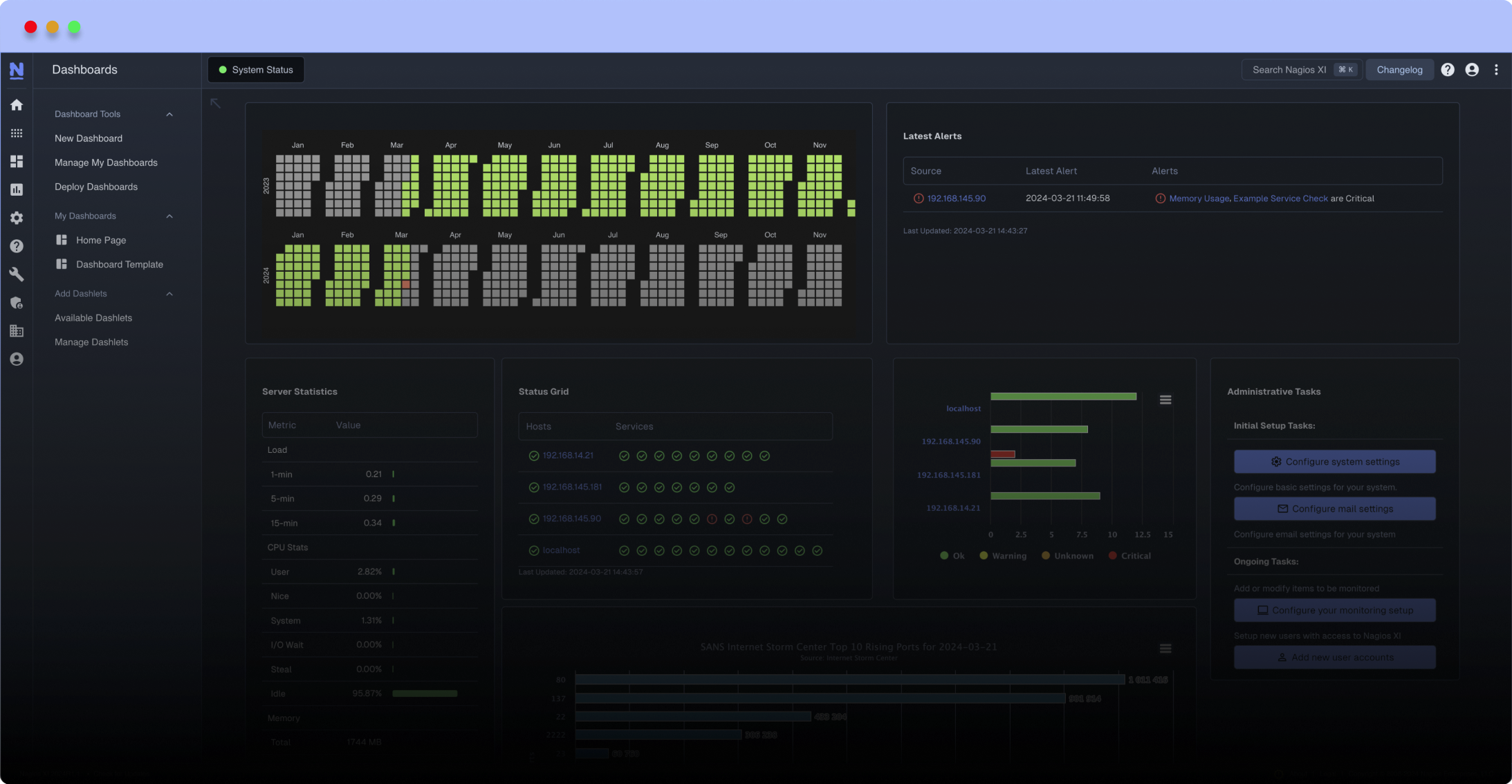Search Exchange
Search All Sites
Nagios Live Webinars
Let our experts show you how Nagios can help your organization.Login
Directory Tree
Sensaphone IMS-4000 (check_ims_sensor)
Current Version
5
Last Release Date
2015-05-14
Compatible With
- Nagios 3.x
- Nagios 4.x
- Nagios XI
Owner
License
MIT
Hits
7348
Meet The New Nagios Core Services Platform
Built on over 25 years of monitoring experience, the Nagios Core Services Platform provides insightful monitoring dashboards, time-saving monitoring wizards, and unmatched ease of use. Use it for free indefinitely.
Monitoring Made Magically Better
- Nagios Core on Overdrive
- Powerful Monitoring Dashboards
- Time-Saving Configuration Wizards
- Open Source Powered Monitoring On Steroids
- And So Much More!
This plugin will query an input channel for type, label and value and provide screen output based on the channel's configuration on the IMS-4000. Useful to pull data from IMS-4000 into Nagios for long-term graphing and advanced alerts.
Check plugin to pull environment sensor data from a Sensaphone(tm) IMS-4000(tm) monitoring system.
This plugin will query an input channel for type, label and value and provide screen output based on the channel's configuration on the IMS-4000. Currently supported sensor types are:
Temperature (C or F)
Sound, usually from internal mic (dB)
Power input (0 or 1, 0 is normal)
Humidity (% relative humidity)
Water sensor (0 or 1)
N.O. Dry contact (0 or 1)
Requirements
This plugin should run on most typical perl installations that provide:
perl 5.8 or higher
Net::SNMP
Getopt::Long
utils.pm from Nagios package
Usage
check_ims_sensor -H [-C ] [-n ] -I [options]
Mandatory arguments
-H, --host Host address ($HOSTADDRESS$ frrom Nagios)
-I, --input Input channel number (starting from 1)
Optional arguments
-C, --community SNMP community string (defaults to 'public')
-n, --node Node number (Starts from 1; defaults to 0 for IMS Host)
-w, --warning Warning threshold
-c, --critical Critical threshold
-v, --verbose Verbose/debugging output
-u, --unit Override value unit string
-t, --type Override input type string
--list-sensors List available sensors on the selected node
Both the warning and critical thresholds support Nagios range syntax for high and low thresholds. The string overrides are only used in the screen output of the Nagios plugin. The performance data automatically uses the input channel's proper unit and type; this prevents RRD series from changing if you change a channel label in IMS.
Using sensors
Dry contacts
This plugin currently only supports normally-open (N.O.) dry contacts (that's all I have). An N.O. input is automatially assumed to be in 'OK' state when open and 'CRITICAL' state when closed.
This plugin will query an input channel for type, label and value and provide screen output based on the channel's configuration on the IMS-4000. Currently supported sensor types are:
Temperature (C or F)
Sound, usually from internal mic (dB)
Power input (0 or 1, 0 is normal)
Humidity (% relative humidity)
Water sensor (0 or 1)
N.O. Dry contact (0 or 1)
Requirements
This plugin should run on most typical perl installations that provide:
perl 5.8 or higher
Net::SNMP
Getopt::Long
utils.pm from Nagios package
Usage
check_ims_sensor -H
Mandatory arguments
-H, --host Host address ($HOSTADDRESS$ frrom Nagios)
-I, --input Input channel number (starting from 1)
Optional arguments
-C, --community SNMP community string (defaults to 'public')
-n, --node Node number (Starts from 1; defaults to 0 for IMS Host)
-w, --warning Warning threshold
-c, --critical Critical threshold
-v, --verbose Verbose/debugging output
-u, --unit Override value unit string
-t, --type Override input type string
--list-sensors List available sensors on the selected node
Both the warning and critical thresholds support Nagios range syntax for high and low thresholds. The string overrides are only used in the screen output of the Nagios plugin. The performance data automatically uses the input channel's proper unit and type; this prevents RRD series from changing if you change a channel label in IMS.
Using sensors
Dry contacts
This plugin currently only supports normally-open (N.O.) dry contacts (that's all I have). An N.O. input is automatially assumed to be in 'OK' state when open and 'CRITICAL' state when closed.
Reviews (1)
byrogue_admin, July 15, 2015
I'm using CentOS 7.1 with Nagios Core 4.1rc
I had a slight issue getting this to work out of the box. I had to add a line of code to correct the following error:
"Can't locate utils.pm in @INC (@INC contains: . /usr/lib/nagios/libexec /usr/local/lib64/perl5 /usr/local/share/perl5 /usr/lib64/perl5/vendor_perl /usr/share/perl5/vendor_perl /usr/lib64/perl5 /usr/share/perl5)"
It's simple though, just mod the check_ims_sensor file by adding the line:
use lib "/usr/local/nagios/libexec";
under the line: use lib qw ( . /usr/lib/nagios/libexec );
And it got rid of the error and worked like a champ.
My only question is if and when the battery check will be supported. As I got the following
"Error: Input type battery is unsupported at this time."
Just curious. it's no big.
Gonna go check out the APC plugin now.
Thanks for making this!
I had a slight issue getting this to work out of the box. I had to add a line of code to correct the following error:
"Can't locate utils.pm in @INC (@INC contains: . /usr/lib/nagios/libexec /usr/local/lib64/perl5 /usr/local/share/perl5 /usr/lib64/perl5/vendor_perl /usr/share/perl5/vendor_perl /usr/lib64/perl5 /usr/share/perl5)"
It's simple though, just mod the check_ims_sensor file by adding the line:
use lib "/usr/local/nagios/libexec";
under the line: use lib qw ( . /usr/lib/nagios/libexec );
And it got rid of the error and worked like a champ.
My only question is if and when the battery check will be supported. As I got the following
"Error: Input type battery is unsupported at this time."
Just curious. it's no big.
Gonna go check out the APC plugin now.
Thanks for making this!


 New Listings
New Listings